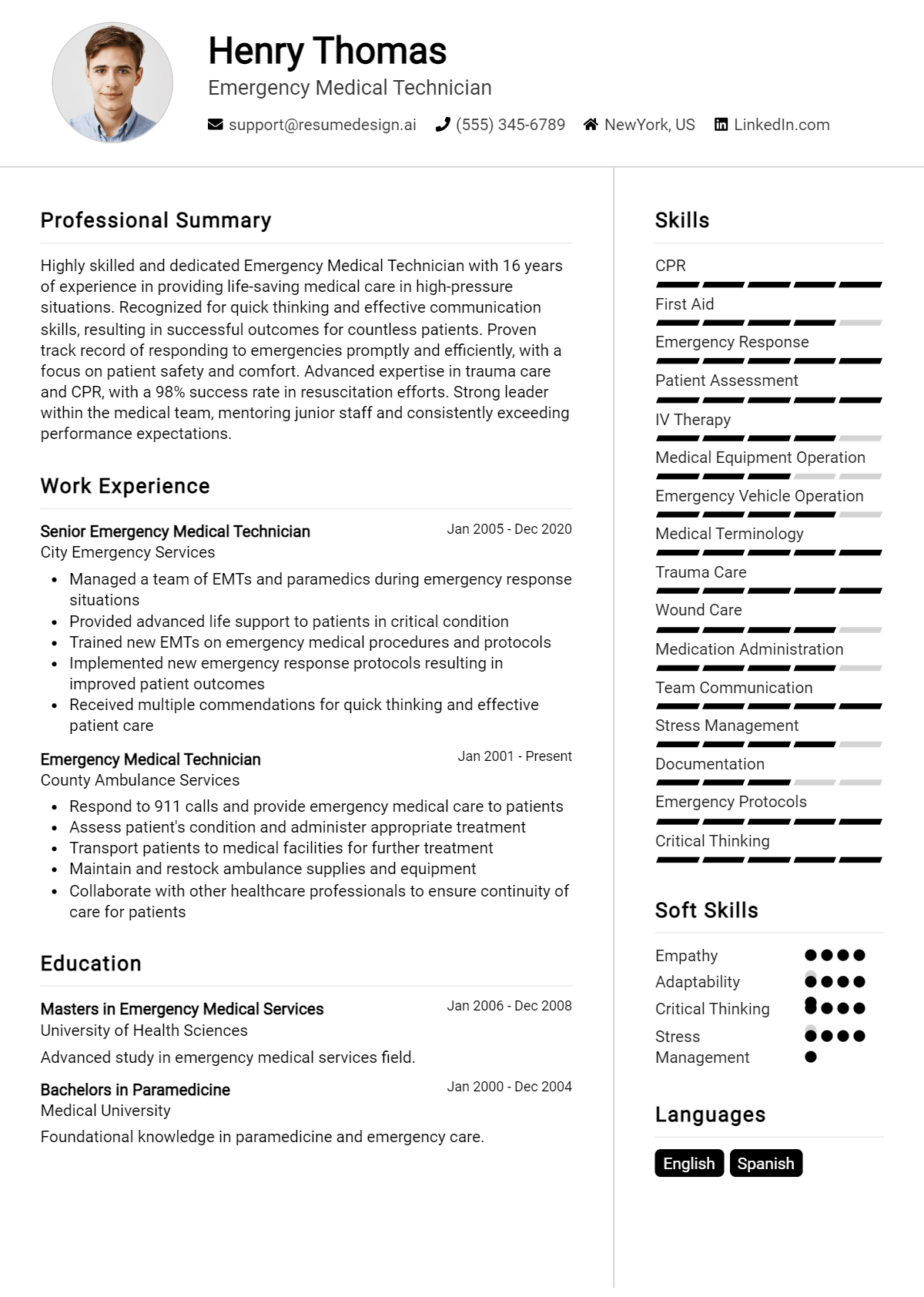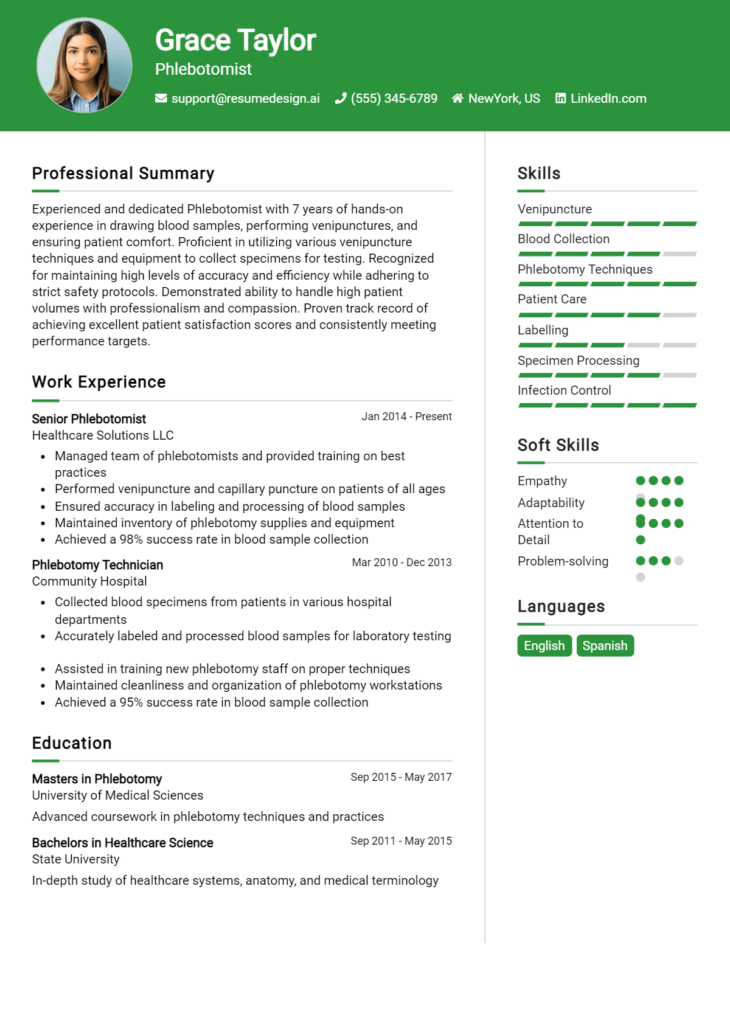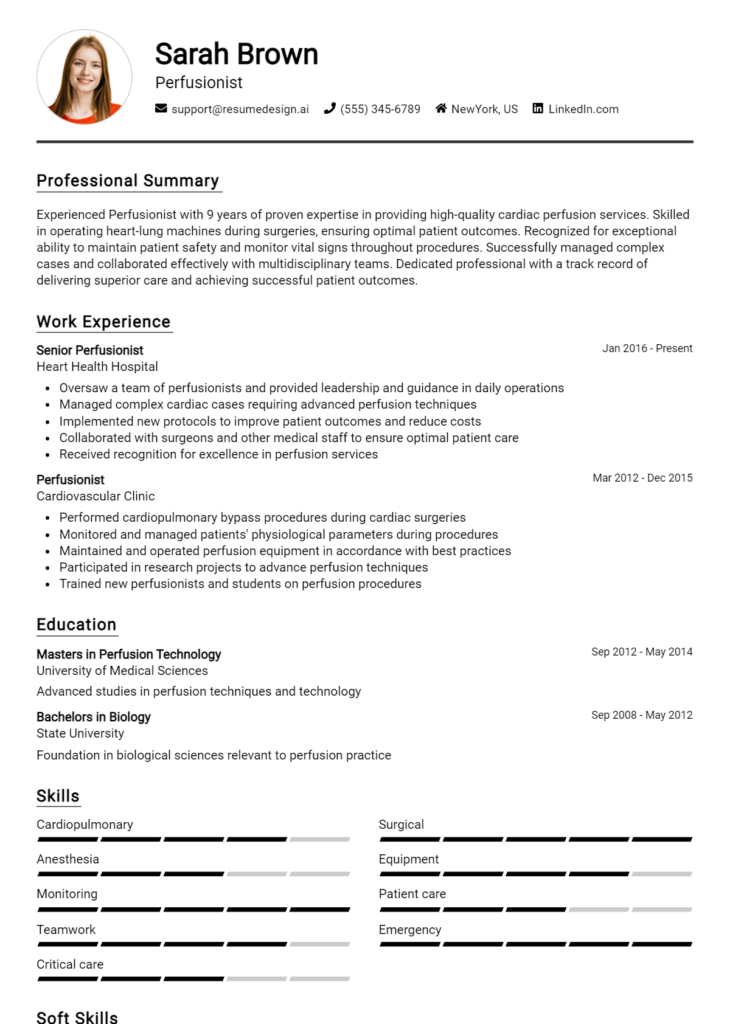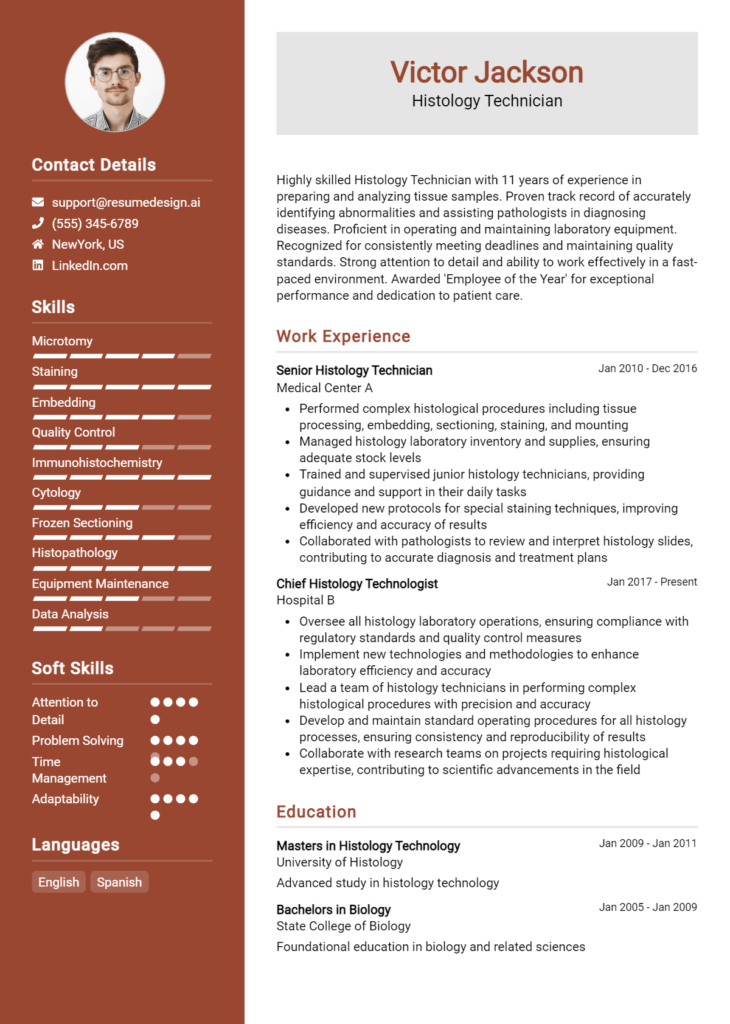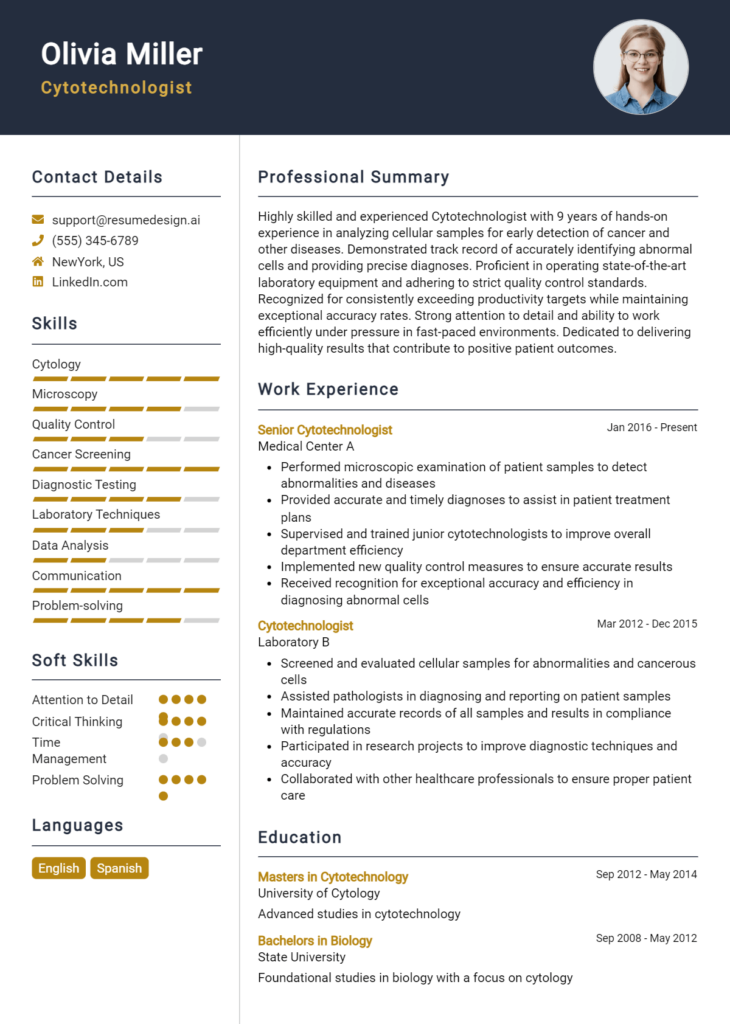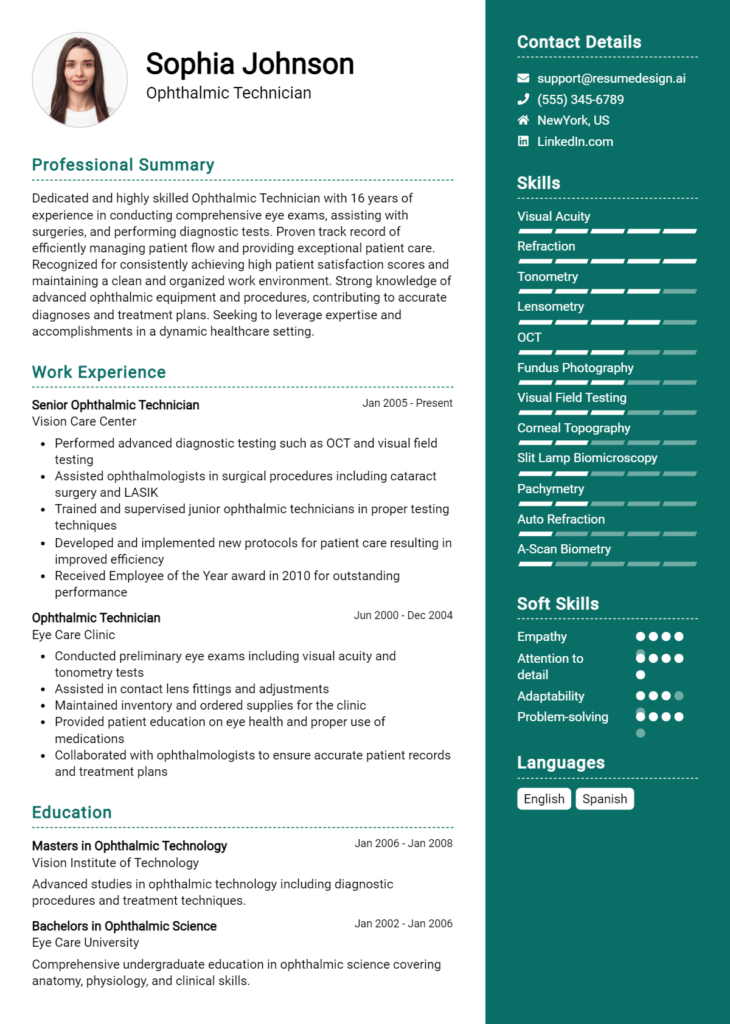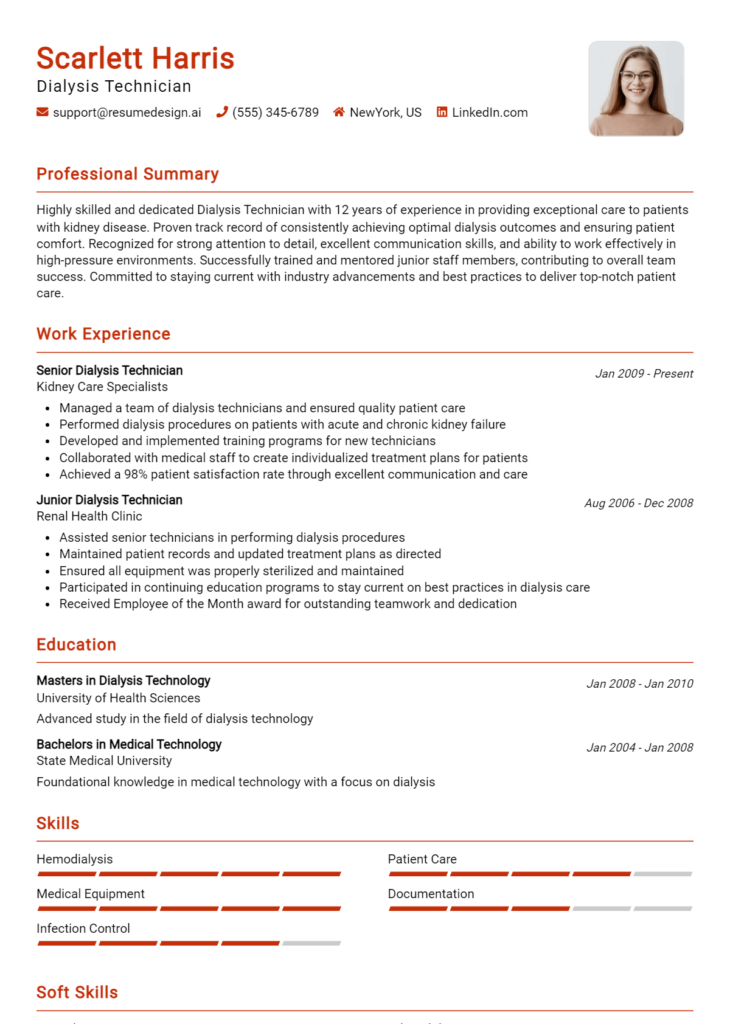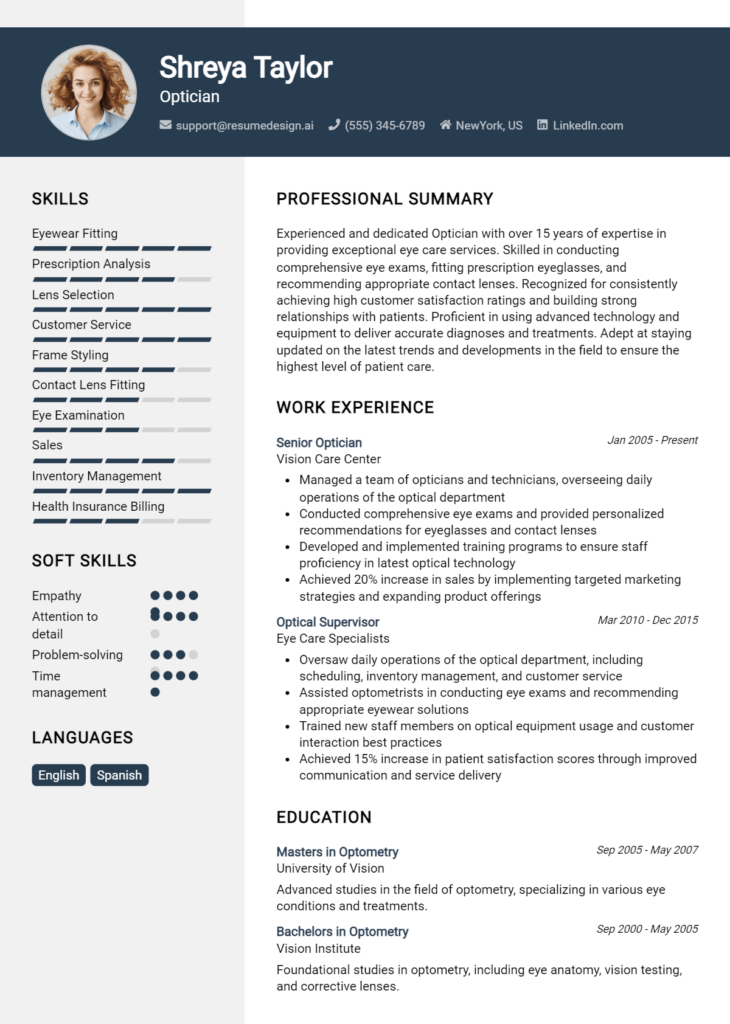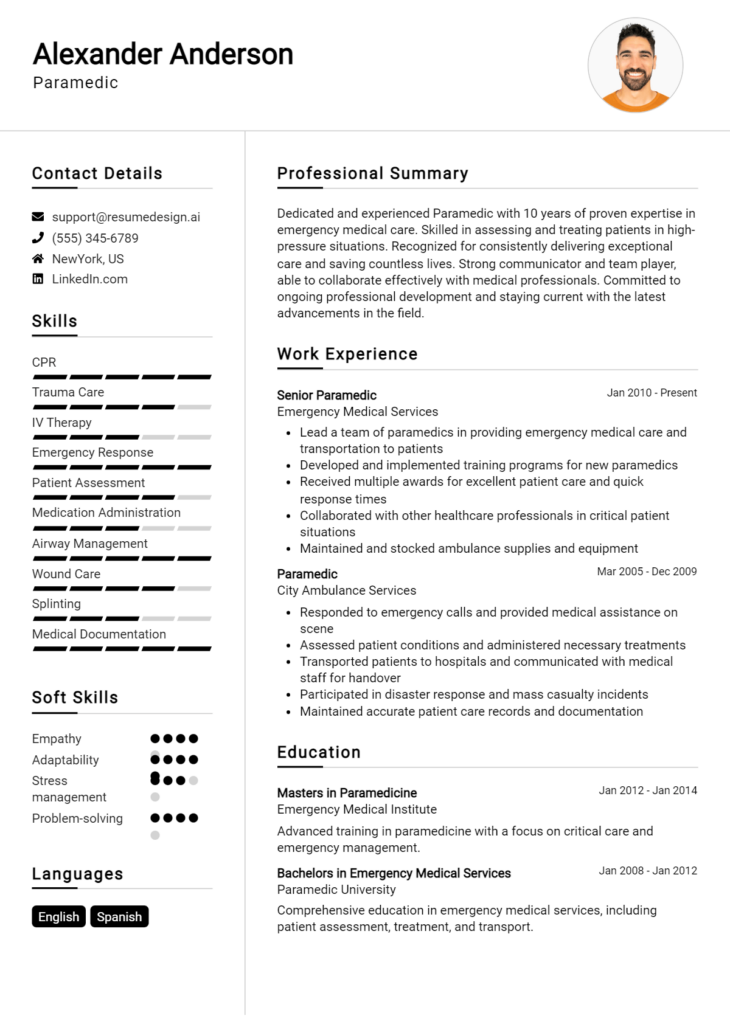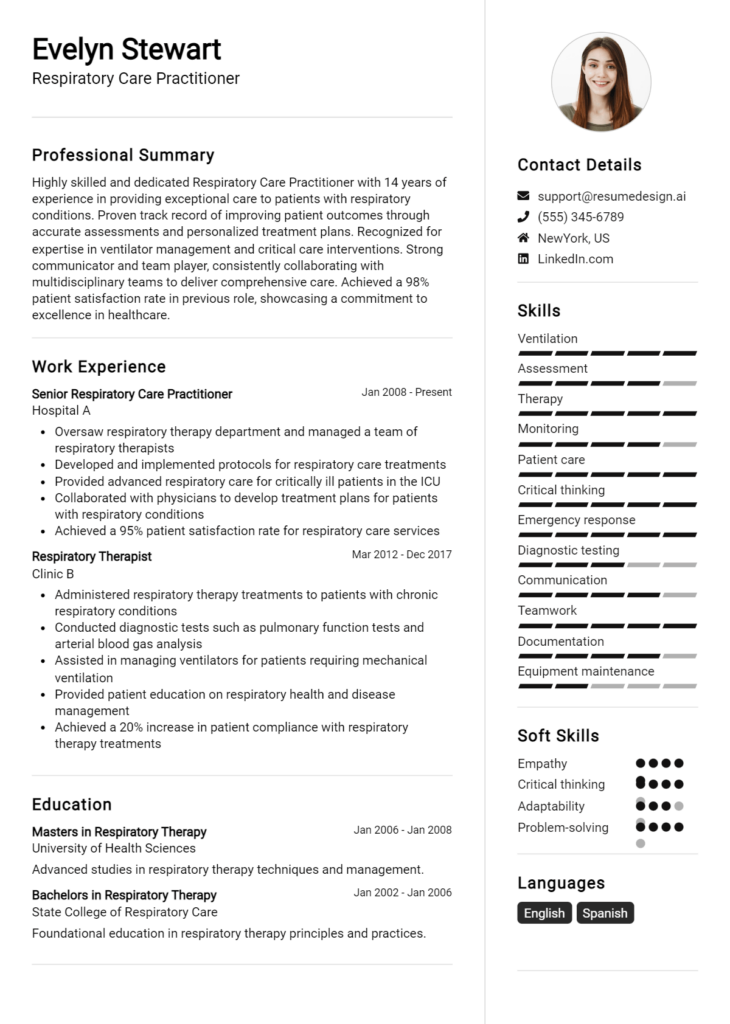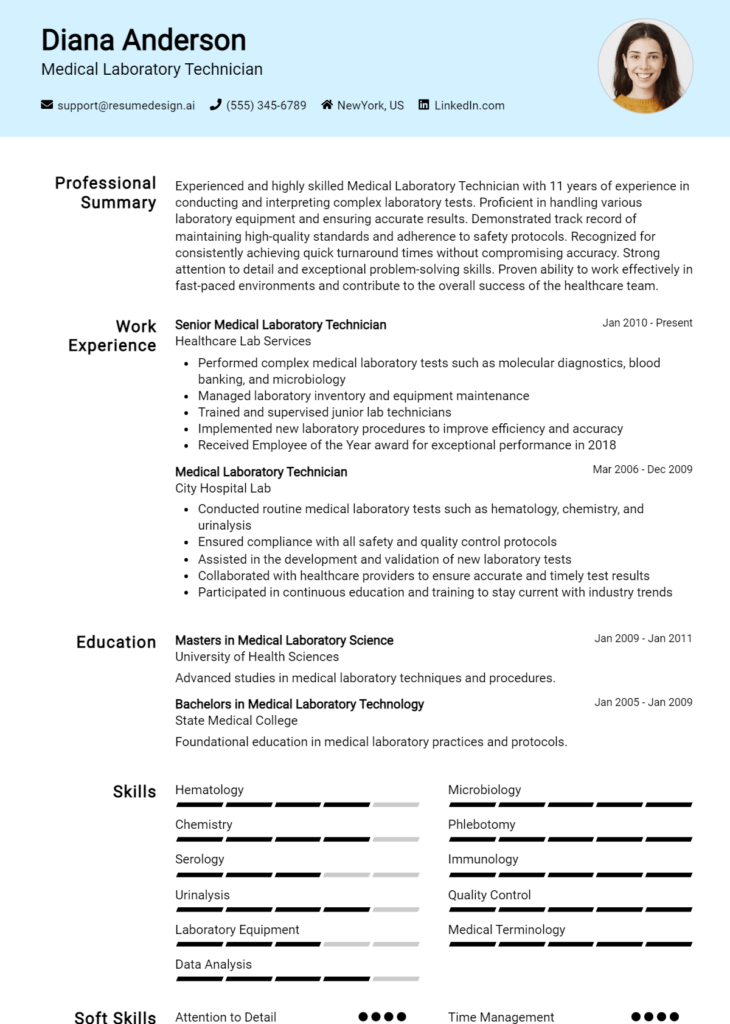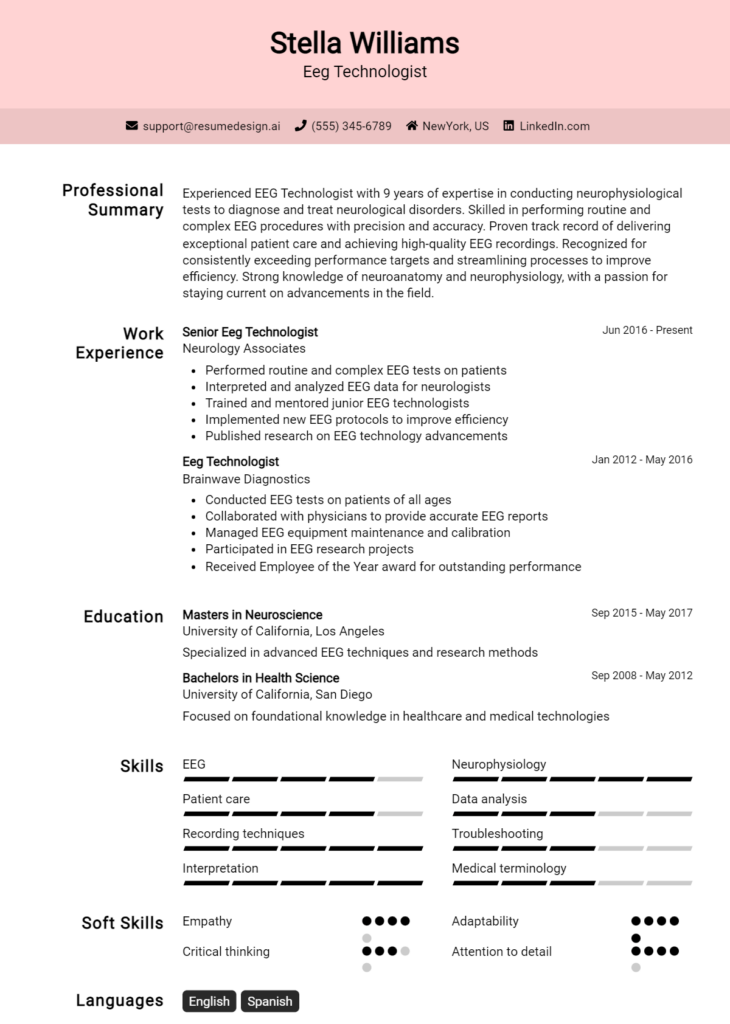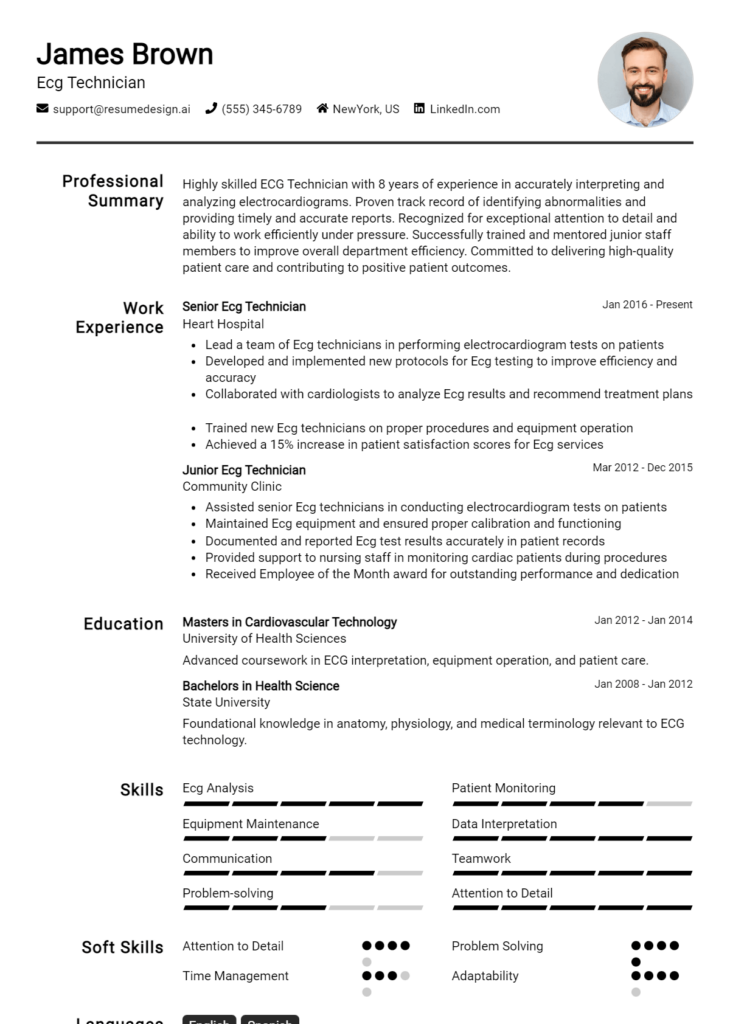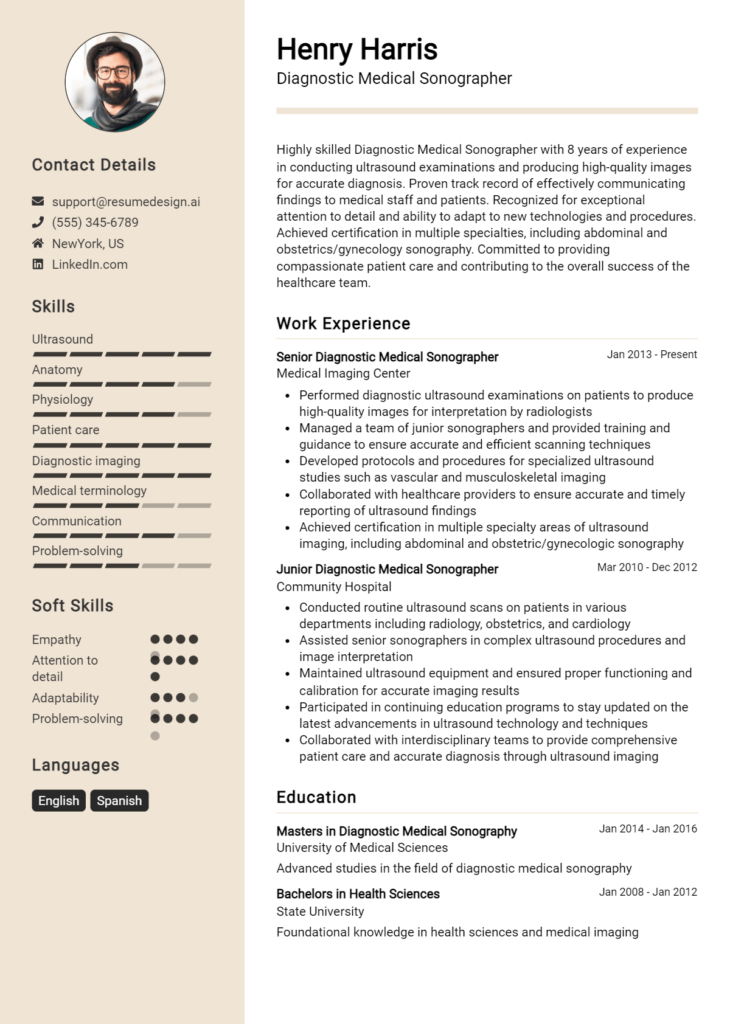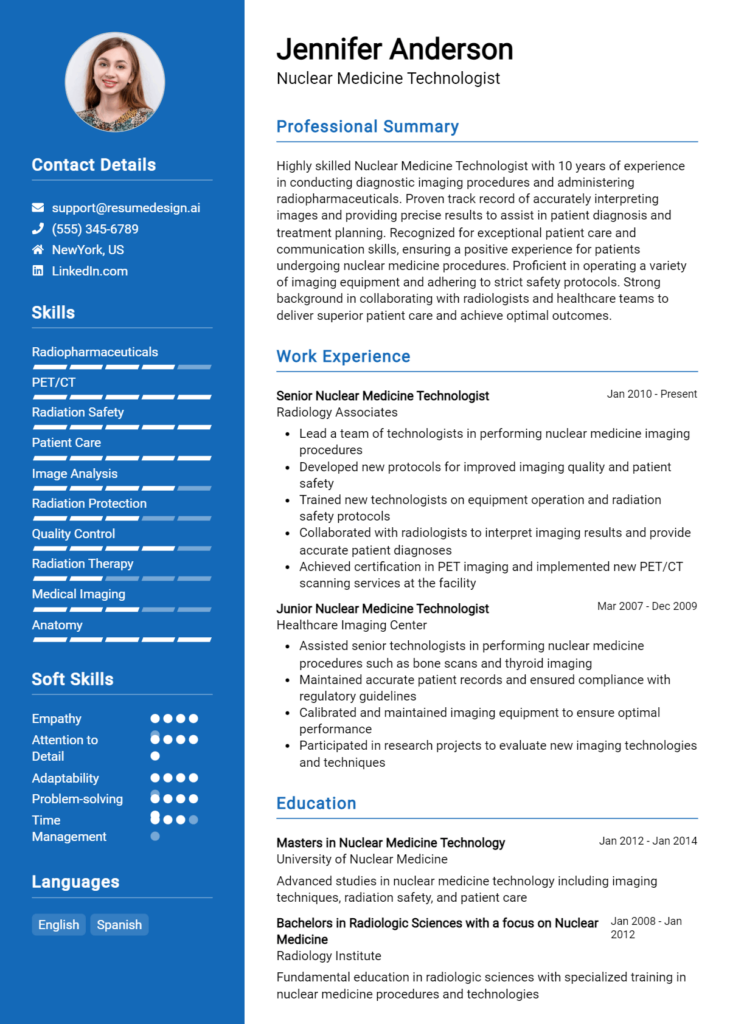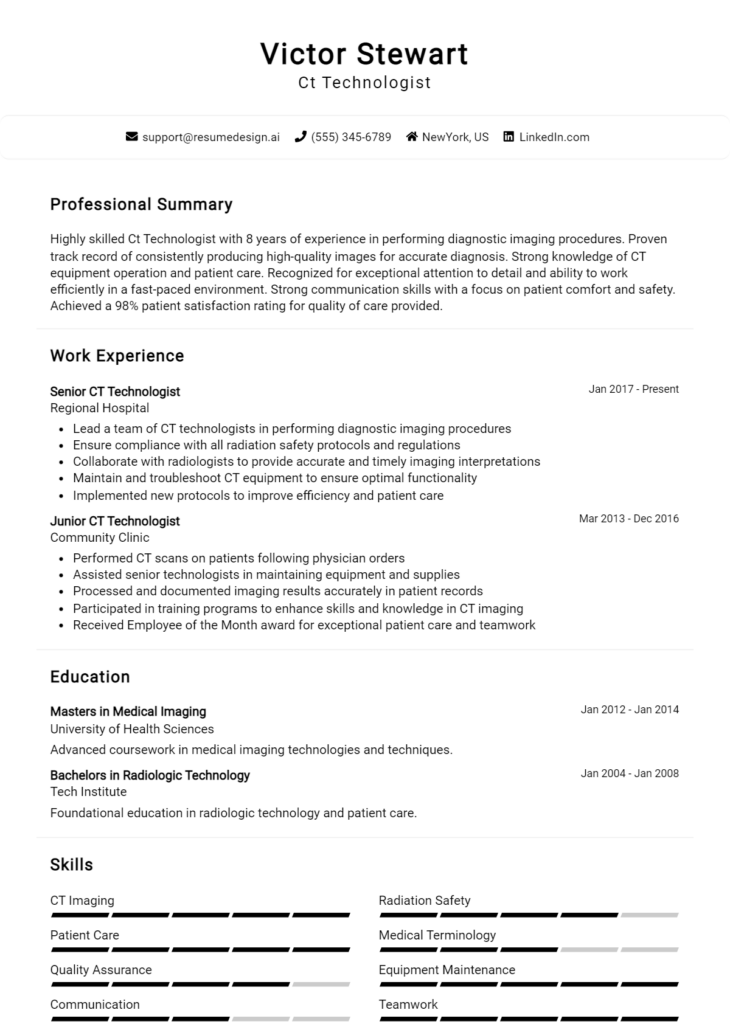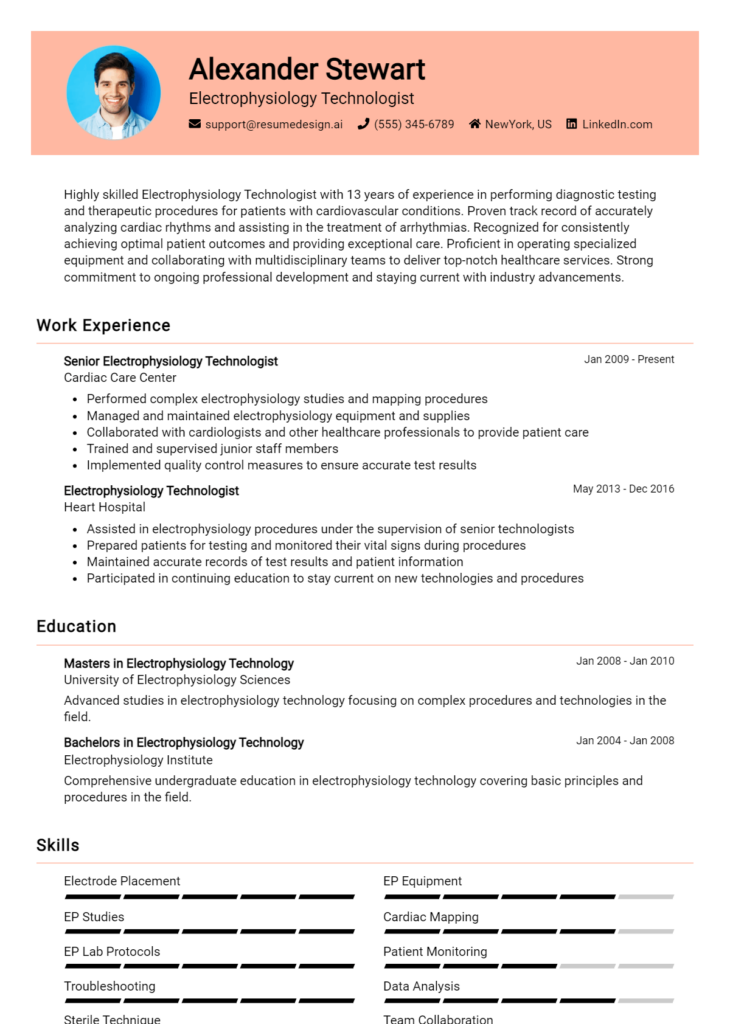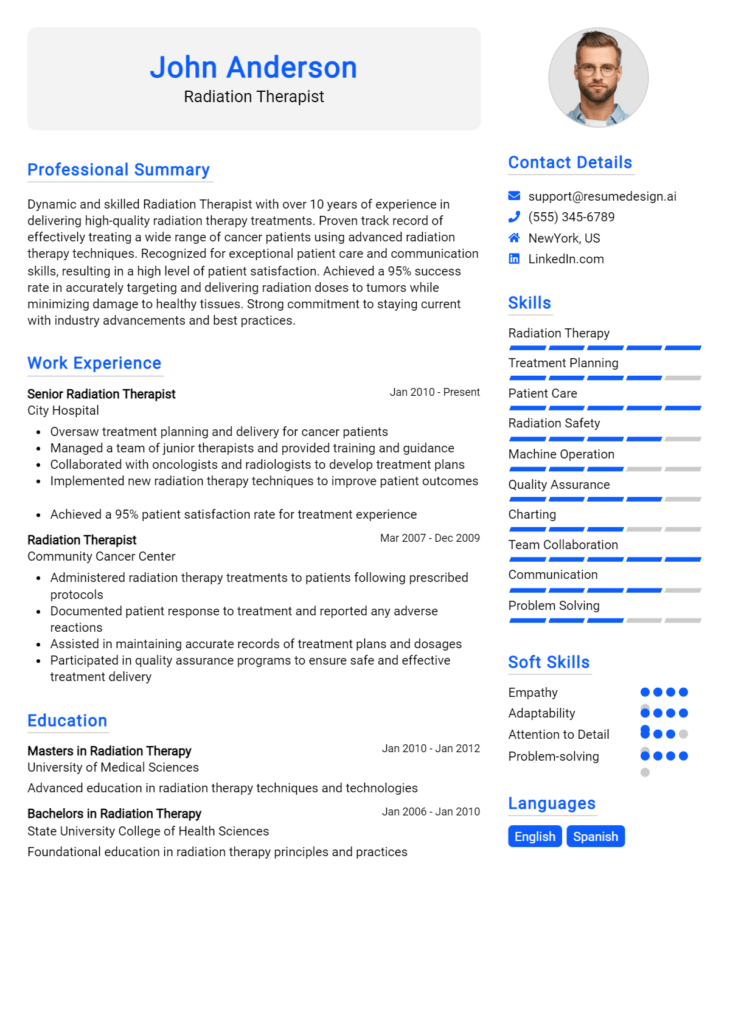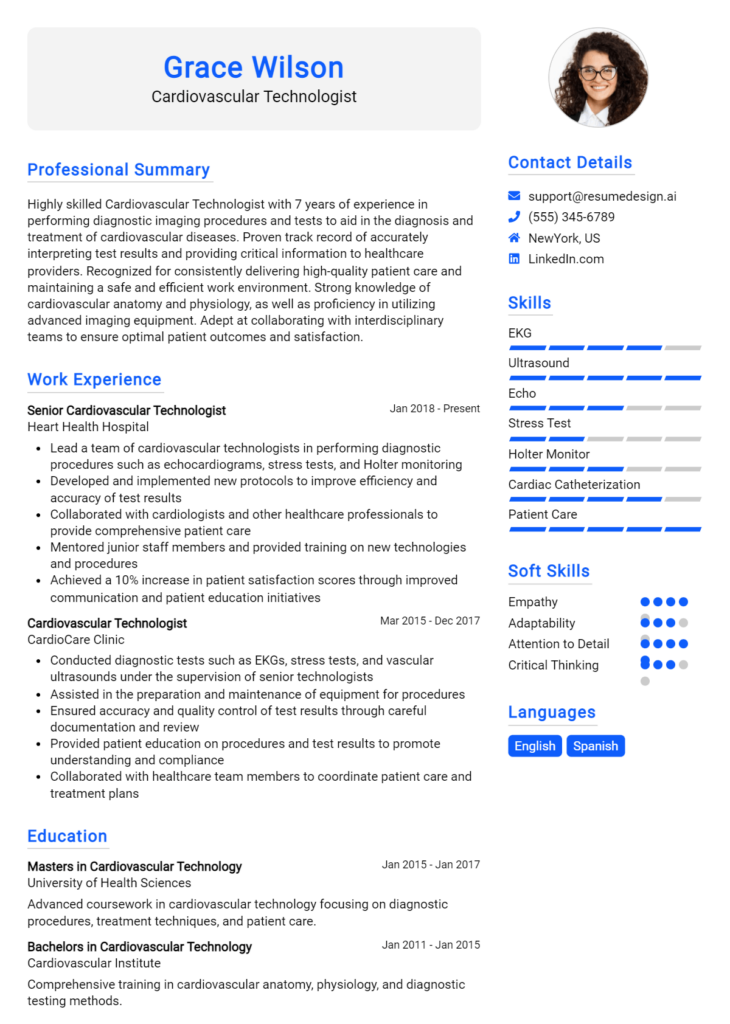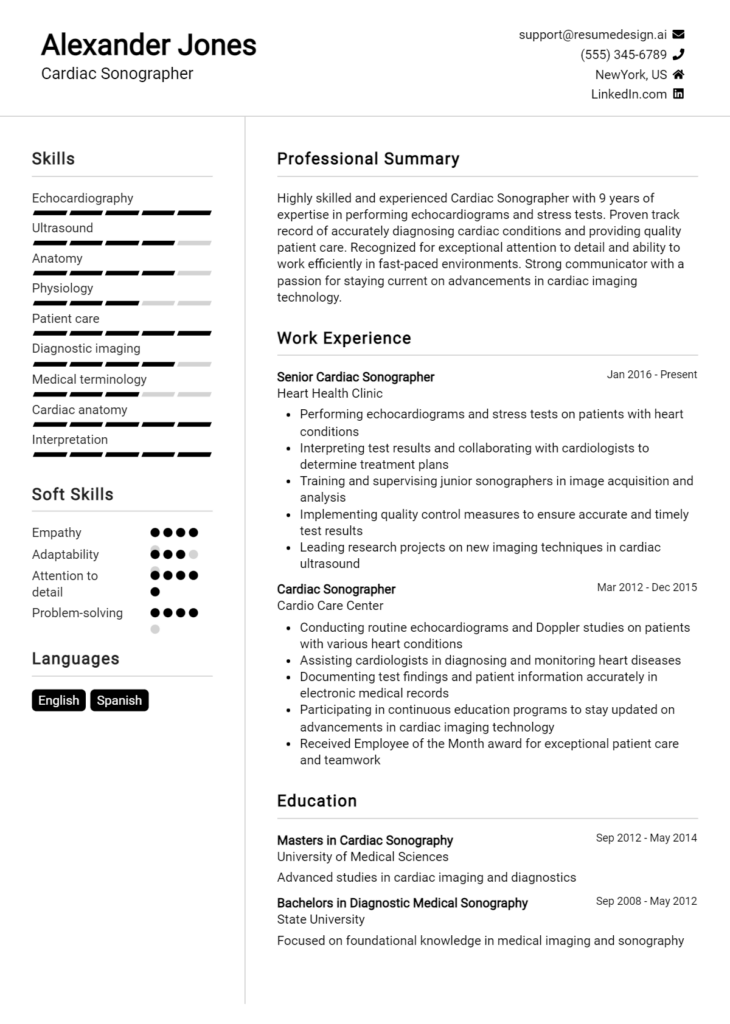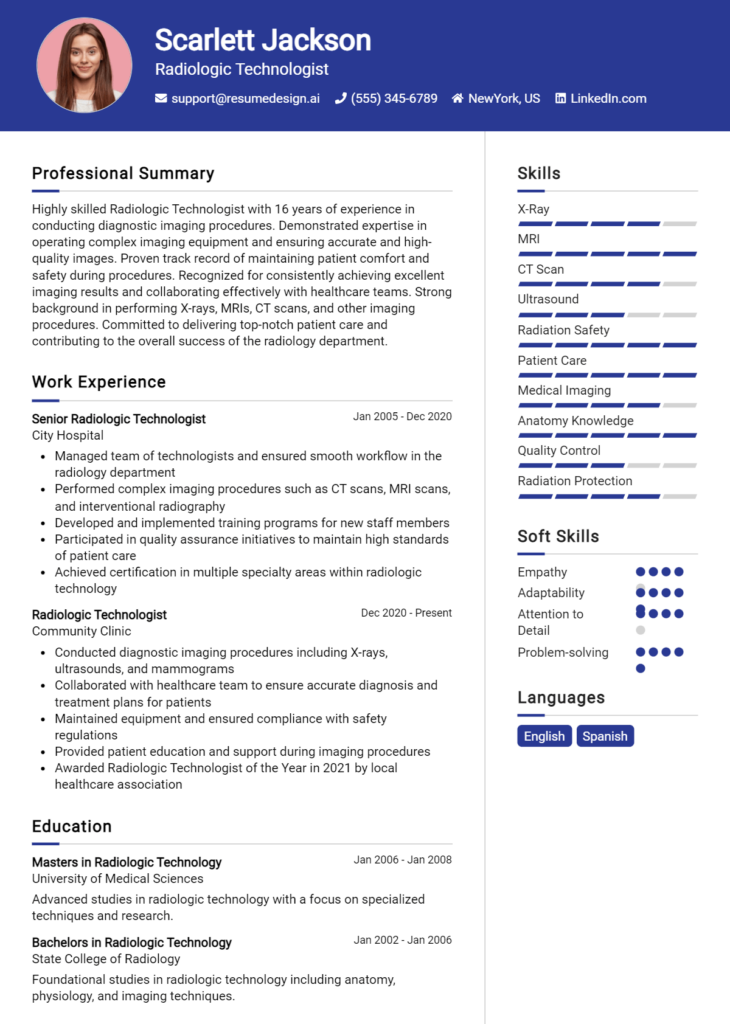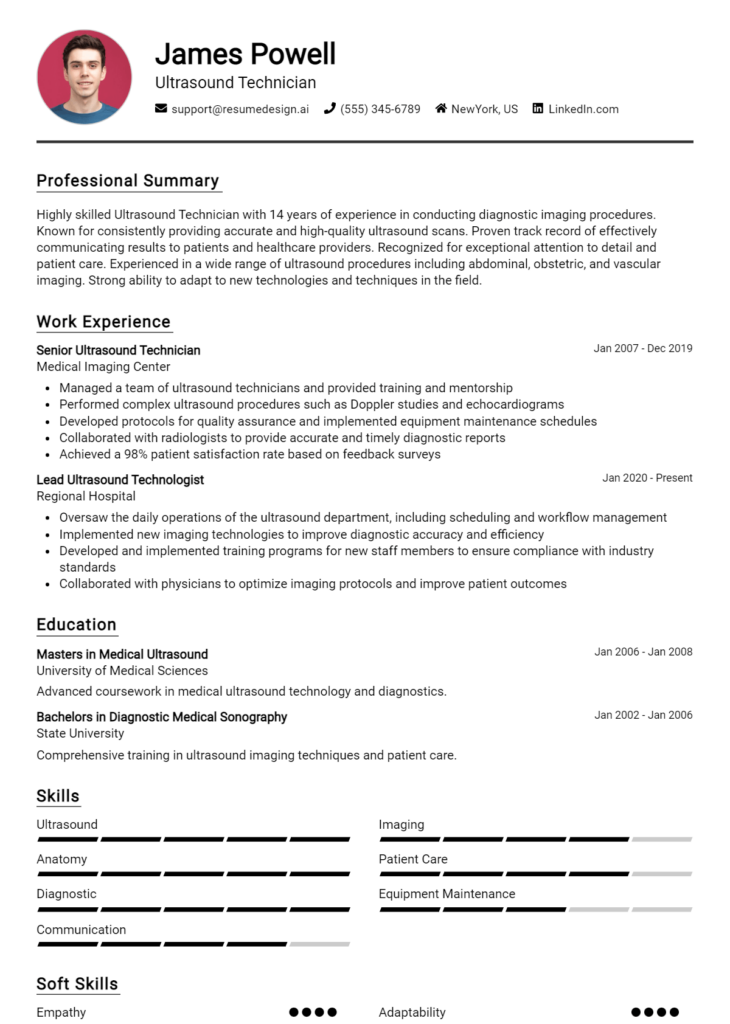Emergency Medical Technician Core Responsibilities
Emergency Medical Technicians (EMTs) play a crucial role in the healthcare system, serving as the vital link between emergency services and medical facilities. Their core responsibilities include assessing patients' conditions, providing life-saving interventions, and ensuring safe transport to hospitals. EMTs must possess strong technical skills, operational knowledge, and exceptional problem-solving abilities to navigate high-pressure situations effectively. These competencies contribute significantly to organizational goals, and a well-crafted resume can highlight these vital qualifications, enhancing career opportunities.
Common Responsibilities Listed on Emergency Medical Technician Resume
- Conducting patient assessments and triage in emergency situations.
- Administering first aid and CPR as needed.
- Operating emergency medical equipment and vehicles.
- Maintaining accurate patient records and documentation.
- Communicating effectively with dispatch, medical staff, and patients.
- Assisting in the stabilization of patients during transport.
- Participating in ongoing training and professional development.
- Collaborating with other emergency services and healthcare providers.
- Ensuring compliance with health and safety regulations.
- Managing stress and making quick decisions in critical situations.
- Educating the public on emergency response and safety practices.
High-Level Resume Tips for Emergency Medical Technician Professionals
A well-crafted resume is crucial for Emergency Medical Technician (EMT) professionals as it serves as the first impression a candidate makes on potential employers. In a field where quick decision-making and effective communication are essential, your resume must reflect not only your technical skills but also your achievements and dedication to patient care. A strong resume can set you apart in a competitive job market, showcasing your ability to handle high-pressure situations and work collaboratively with healthcare teams. This guide will provide practical and actionable tips specifically tailored for EMT professionals, ensuring that your resume effectively highlights your qualifications and increases your chances of securing your desired role.
Top Resume Tips for Emergency Medical Technician Professionals
- Tailor your resume to match the specific job description, using keywords that align with the employer's requirements.
- Highlight relevant experience, including internships, volunteer work, and previous EMT positions that demonstrate your capabilities.
- Quantify your achievements by including metrics, such as the number of patients treated or response times, to illustrate your impact.
- Showcase industry-specific skills, such as CPR certification, first aid proficiency, and knowledge of emergency protocols.
- Include a summary statement at the top of your resume that encapsulates your experience and passion for emergency medical services.
- Utilize action verbs to describe your responsibilities and accomplishments, creating a dynamic and engaging narrative.
- Keep your resume concise, ideally one page, while ensuring it includes all relevant information without overwhelming the reader.
- Incorporate any additional certifications or training, such as Advanced Cardiac Life Support (ACLS) or Pediatric Advanced Life Support (PALS), to enhance your qualifications.
- Ensure your resume is free from errors and formatted neatly, as attention to detail is critical in the medical field.
- Consider including a section for professional affiliations, such as membership in the National Association of Emergency Medical Technicians (NAEMT), to demonstrate your commitment to the profession.
By implementing these tips, you can significantly increase your chances of landing a job in the Emergency Medical Technician field. A well-structured and targeted resume will not only highlight your qualifications but also communicate your readiness to excel in high-stakes environments, making you a compelling candidate for potential employers.
Why Resume Headlines & Titles are Important for Emergency Medical Technician
In the competitive field of emergency medical services, a compelling resume headline or title serves as the first impression a candidate makes on hiring managers. For an Emergency Medical Technician (EMT), the headline is not just a label but a powerful tool that summarizes key qualifications and sets the tone for the entire resume. A strong headline can immediately grab attention, showcasing the candidate’s expertise and making a memorable impact. It should be concise and relevant, directly related to the EMT role, effectively conveying the unique strengths and experiences that differentiate the applicant from others.
Best Practices for Crafting Resume Headlines for Emergency Medical Technician
- Keep it concise: Limit the headline to one or two impactful phrases.
- Be specific: Use language that directly relates to the EMT role and responsibilities.
- Highlight key qualifications: Mention relevant certifications, skills, or experience.
- Use action words: Start with strong verbs that convey competence and readiness.
- Tailor to the job description: Align your headline with the specific requirements of the position.
- Avoid jargon: Use clear language that can be understood by all hiring managers.
- Showcase achievements: If applicable, include quantifiable accomplishments to stand out.
- Maintain professionalism: Ensure the tone is appropriate for a medical and emergency service context.
Example Resume Headlines for Emergency Medical Technician
Strong Resume Headlines
Compassionate EMT with 5 Years of Experience in High-Pressure Environments
Certified Emergency Medical Technician Specializing in Pediatric Care
Dedicated EMT with Proven Track Record in Rapid Response and Patient Care
Experienced EMT and CPR Instructor Committed to Community Health and Safety
Weak Resume Headlines
Just Another EMT Looking for Work
EMT with Some Experience
Seeking a Job in Healthcare
The strong headlines are effective because they convey specific qualifications, demonstrate expertise, and encapsulate the candidate's strengths in a manner that is both relevant and compelling. They immediately communicate the candidate's value to potential employers. In contrast, the weak headlines fail to impress due to their vagueness and lack of focus, making it difficult for hiring managers to gauge the candidate's suitability for the role. By avoiding generic statements and instead highlighting key skills and experiences, candidates can significantly enhance their chances of standing out in the hiring process.
Writing an Exceptional Emergency Medical Technician Resume Summary
Crafting a compelling resume summary is crucial for Emergency Medical Technicians (EMTs) seeking to stand out in a competitive job market. A strong summary serves as an elevator pitch, quickly capturing the attention of hiring managers by highlighting key skills, relevant experience, and notable accomplishments directly related to the EMT role. An effective summary should be concise yet impactful, tailored to the specific job description, and designed to demonstrate the candidate's capacity to excel in emergency medical situations. This snapshot of qualifications sets the tone for the rest of the resume, making it essential for job seekers to invest time in perfecting this section.
Best Practices for Writing a Emergency Medical Technician Resume Summary
- Start with a strong opening statement that captures your core professional identity.
- Quantify your achievements where possible (e.g., "responded to over 300 emergency calls").
- Focus on key skills relevant to the EMT role, such as patient assessment and emergency response.
- Tailor the summary to match the specific job description and requirements.
- Highlight certifications and training that enhance your qualifications (e.g., CPR, advanced first aid).
- Use active language and strong action verbs to convey your experience effectively.
- Keep it concise—ideally 2-4 sentences that deliver maximum impact.
- Showcase any leadership or teamwork experiences that demonstrate your ability to work under pressure.
Example Emergency Medical Technician Resume Summaries
Strong Resume Summaries
Dedicated Emergency Medical Technician with over 5 years of experience providing high-quality emergency care and support in fast-paced environments. Successfully responded to more than 500 emergency calls, ensuring timely transport and treatment of patients. Certified in Advanced Cardiac Life Support (ACLS) and Pediatric Advanced Life Support (PALS).
Compassionate EMT specializing in trauma assessment and emergency response, with a proven track record of improving patient outcomes through effective teamwork and communication. Recognized for maintaining a 98% patient satisfaction rating in emergency services over the past year.
Results-driven Emergency Medical Technician with extensive experience in pre-hospital care, adept at assessing patient conditions and administering life-saving interventions. Achieved a 30% reduction in average response times through optimized dispatch protocols.
Weak Resume Summaries
I am an EMT with some experience in emergency situations and patient care.
Emergency Medical Technician looking for a job where I can use my skills to help people.
The examples provided illustrate clear distinctions between strong and weak summaries. The strong summaries effectively highlight specific achievements, quantifiable results, and relevant skills that align with the EMT role, making them impactful and tailored for the job. In contrast, the weak summaries are vague and generic, lacking detail and failing to convey the candidate's qualifications, which diminishes their appeal to hiring managers.
Work Experience Section for Emergency Medical Technician Resume
The work experience section is a critical component of an Emergency Medical Technician (EMT) resume, as it serves to highlight the candidate's hands-on experience in high-pressure situations. This section not only showcases technical skills—such as proficiency in life-support techniques and emergency care—but also emphasizes the ability to manage teams effectively and deliver high-quality patient care. By quantifying achievements and aligning work experiences with industry standards, candidates can demonstrate their impact and readiness for the challenges of the EMT role.
Best Practices for Emergency Medical Technician Work Experience
- Focus on quantifiable achievements, such as the number of patients treated or response times improved.
- Highlight specific technical skills relevant to emergency medical services, such as CPR certification or advanced life support training.
- Emphasize teamwork and collaboration by detailing experiences working with other healthcare professionals.
- Use action verbs to convey a strong sense of initiative and responsibility in past roles.
- Align experience descriptions with industry standards and terminology to resonate with hiring managers.
- Include relevant certifications and training that enhance your qualifications as an EMT.
- Showcase leadership roles or responsibilities taken during emergencies or in training scenarios.
- Keep descriptions concise but impactful, focusing on the most relevant experiences.
Example Work Experiences for Emergency Medical Technician
Strong Experiences
- Delivered life-saving interventions to over 150 patients annually, resulting in a 30% improvement in survival rates during critical emergencies.
- Led a team of 5 EMTs in a high-volume urban area, achieving an average response time of under 5 minutes for emergency calls.
- Implemented new training protocols that increased proficiency in advanced life support techniques by 40% among team members.
- Collaborated with local hospitals to streamline patient handoff processes, which reduced wait times for emergency care by 25%.
Weak Experiences
- Worked as an EMT for a few years and helped people.
- Responded to emergency calls and provided care.
- Participated in training sessions with colleagues occasionally.
- Assisted with patient transport and wrote reports.
The examples provided highlight the importance of specificity and quantifiable results in the work experience section. The strong experiences illustrate concrete achievements and demonstrate a proactive approach to emergency medical care, while the weak experiences lack detail and fail to convey the candidate's impact or capabilities. Strong experiences effectively communicate the candidate's value through metrics and leadership roles, while weak experiences come across as vague and unimpressive, providing little insight into the candidate's true skill set.
Education and Certifications Section for Emergency Medical Technician Resume
The education and certifications section of an Emergency Medical Technician (EMT) resume is crucial as it serves to showcase the candidate's academic background and relevant certifications that validate their skills in emergency medical care. This section not only emphasizes the foundational knowledge acquired through formal education but also highlights the industry-recognized certifications that demonstrate the candidate's commitment to continuous learning and adherence to current best practices in emergency medicine. By including relevant coursework and specialized training, candidates can significantly enhance their credibility and alignment with the requirements of the job role, making a compelling case to potential employers.
Best Practices for Emergency Medical Technician Education and Certifications
- Include only relevant degrees and certifications that directly pertain to the EMT role.
- List certifications in order of relevance, starting with the most critical, such as CPR and Advanced Cardiac Life Support (ACLS).
- Provide details on relevant coursework that enhances your qualifications, especially in emergency care, anatomy, and physiology.
- Highlight any specialized training or workshops that demonstrate ongoing professional development.
- Use clear and concise language to ensure easy readability and comprehension.
- Include the date of completion for certifications to show currency and relevance.
- If applicable, mention affiliations with professional organizations that reflect your commitment to the field.
- Consider adding honors or distinctions received during your education to stand out.
Example Education and Certifications for Emergency Medical Technician
Strong Examples
- Associate Degree in Emergency Medical Services, ABC Community College, May 2023
- National Registry of Emergency Medical Technicians (NREMT) Certification, June 2023
- CPR and First Aid Certification, American Heart Association, September 2023
- Advanced Pediatric Life Support (APLS) Certification, Pediatric Emergency Medicine, November 2022
Weak Examples
- Bachelor's Degree in English Literature, XYZ University, May 2020
- Certification in Basic Computer Skills, Local Community Center, March 2021
- High School Diploma, ABC High School, Graduated 2018
- Outdated EMT-Basic Certification from 2015 (not renewed)
The strong examples are considered relevant as they directly pertain to the skills and knowledge required for the EMT role, showcasing both recent education and current certifications that are recognized in the industry. In contrast, the weak examples are deemed irrelevant because they do not relate to emergency medical services or are outdated, failing to reflect the candidate's readiness for the EMT position.
Top Skills & Keywords for Emergency Medical Technician Resume
The role of an Emergency Medical Technician (EMT) is critical in the healthcare system, requiring a unique blend of skills to ensure effective patient care and rapid response in emergency situations. A well-crafted resume that highlights relevant skills is essential for standing out in a competitive job market. Potential employers look for both hard and soft skills that demonstrate your capability to handle high-pressure environments, communicate effectively, and provide compassionate care. By showcasing these skills, EMT candidates can effectively convey their qualifications and readiness to meet the challenges of the job. For a deeper understanding of how to enhance your resume, explore more about skills and work experience.
Top Hard & Soft Skills for Emergency Medical Technician
Soft Skills
- Strong Communication Skills
- Compassion and Empathy
- Teamwork and Collaboration
- Problem-Solving Ability
- Adaptability and Flexibility
- Stress Management
- Attention to Detail
- Time Management
- Active Listening
- Decision-Making Skills
Hard Skills
- CPR and First Aid Certification
- Knowledge of Medical Terminology
- Patient Assessment Techniques
- Trauma Care
- Use of Medical Equipment (e.g., AEDs, stretchers)
- Basic Life Support (BLS)
- Advanced Cardiac Life Support (ACLS)
- Emergency Response Protocols
- Knowledge of Pharmacology
- Record Keeping and Documentation Skills
Stand Out with a Winning Emergency Medical Technician Cover Letter
Dear Hiring Manager,
I am writing to express my interest in the Emergency Medical Technician (EMT) position at [Company Name], as advertised on [Job Board/Company Website]. With my extensive training and hands-on experience in emergency response, I am confident in my ability to provide high-quality patient care under pressure. Having completed my EMT certification through [Institution Name] and accumulated over [X years] of field experience, I am well-prepared to contribute effectively to your team.
During my time at [Previous Employer/Volunteer Organization], I successfully responded to a variety of emergency situations, demonstrating my ability to assess patient needs rapidly and deliver critical interventions. I take pride in my strong communication skills, which enable me to work collaboratively with paramedics, nurses, and other healthcare professionals. My commitment to ongoing education in emergency medicine has equipped me with the knowledge of the latest protocols and technologies, ensuring that I remain at the forefront of best practices in patient care.
I am particularly drawn to [Company Name] because of its reputation for excellence in emergency services and community outreach. I am excited about the opportunity to work with a team that prioritizes patient-centered care and continuous improvement. I am eager to bring my skills in patient assessment, life-saving techniques, and compassionate care to your esteemed organization. Thank you for considering my application; I look forward to the opportunity to discuss how I can support your mission to deliver exceptional emergency medical services.
Sincerely,
[Your Name]
[Your Phone Number]
[Your Email Address]
Common Mistakes to Avoid in a Emergency Medical Technician Resume
Crafting an effective resume as an Emergency Medical Technician (EMT) is crucial for standing out in a competitive job market. While you may have the skills and experience necessary for the role, common mistakes can undermine your chances of landing an interview. Understanding these pitfalls can help you create a more polished and professional resume that effectively showcases your qualifications. Here are some common mistakes to avoid:
Generic Objective Statement: Using a one-size-fits-all objective does not convey your specific interest in the EMT position. Tailor your objective to reflect your passion for emergency medical services and how you can contribute to the organization.
Lack of Relevant Certifications: Failing to highlight essential certifications, such as CPR and Advanced Cardiac Life Support (ACLS), can lead employers to overlook your qualifications. Ensure these certifications are prominently displayed in a dedicated section.
Overloading with Technical Jargon: While EMTs should be familiar with medical terminology, overusing technical language can alienate hiring managers who may not be as versed in the field. Strive for clarity and balance technical terms with accessible language.
Neglecting Soft Skills: EMT roles require strong interpersonal skills, such as communication and teamwork. Failing to mention these soft skills can make your resume less appealing. Include examples that demonstrate your ability to work well under pressure.
Inadequate Work Experience Descriptions: Simply listing job titles and dates without elaborating on your responsibilities and achievements can diminish the impact of your experience. Use bullet points to detail specific tasks and outcomes that reflect your capabilities.
Ignoring Quantifiable Achievements: Omitting quantifiable metrics, such as the number of patients treated or response times, can weaken your resume. Whenever possible, include numbers to illustrate the impact of your work.
Poor Formatting: A cluttered or unprofessional layout can distract from your qualifications. Use clear headings, consistent fonts, and bullet points to create an easily readable format that highlights your skills effectively.
Spelling and Grammar Errors: Simple typos and grammatical mistakes can make you appear careless. Always proofread your resume multiple times and consider getting a second pair of eyes to review it for errors.
Conclusion
As we conclude our exploration of the Emergency Medical Technician (EMT) role, it's clear that this profession demands a unique combination of skills, dedication, and resilience. EMTs are often the first responders in emergency situations, requiring not only medical knowledge but also the ability to remain calm under pressure and effectively communicate with patients and their families.
The importance of having a well-structured resume cannot be overstated. A compelling resume highlights your relevant experience, certifications, and skills that make you an ideal candidate for EMT positions. It showcases your ability to handle emergencies, work collaboratively with healthcare teams, and provide compassionate care to patients.
Now is the perfect time to review your Emergency Medical Technician resume. Make sure it reflects your qualifications and readiness for the challenges of this vital role. Utilize available resources to enhance your application materials:
- Explore resume templates that can help you format your information professionally.
- Try out the resume builder to create a customized resume that stands out.
- Check out resume examples for inspiration on how to effectively present your skills and experiences.
- Don't forget to craft a strong first impression with cover letter templates that complement your resume.
Take action today to ensure your resume is as impressive as your commitment to the emergency medical field. Your next opportunity awaits!

